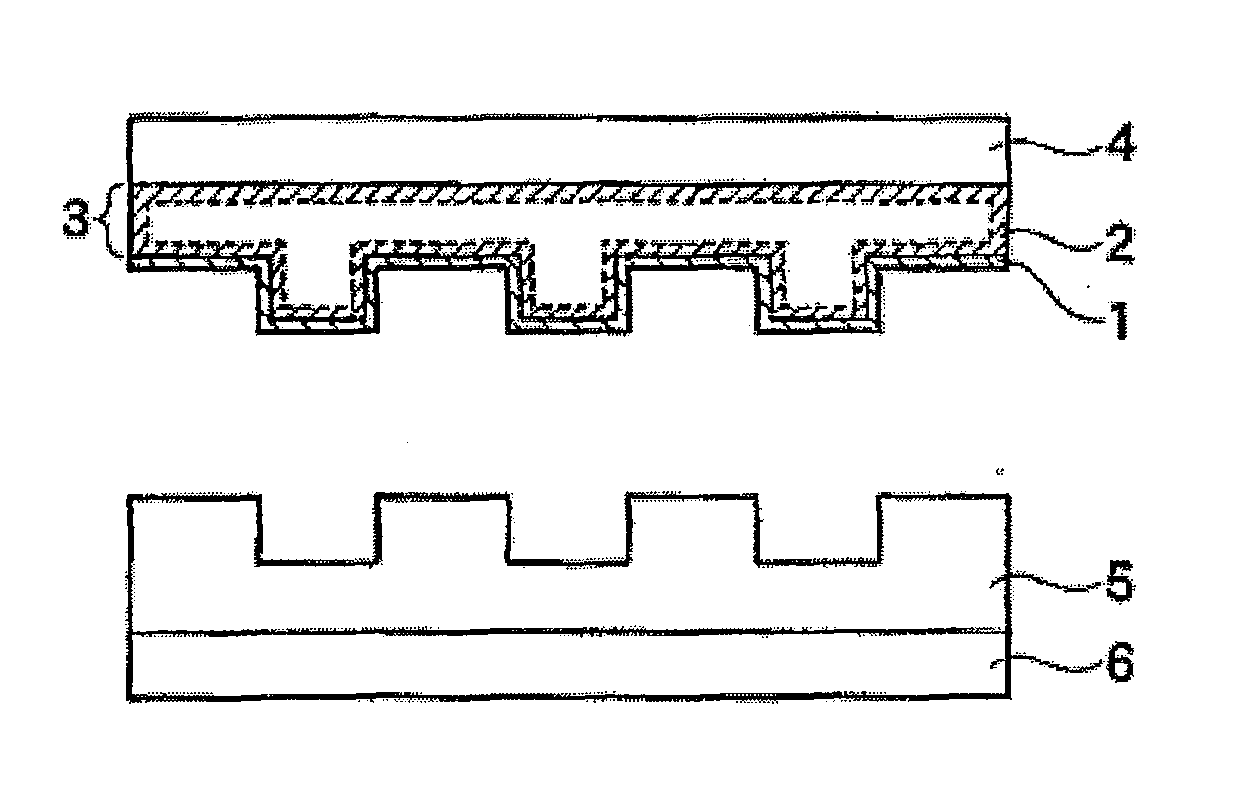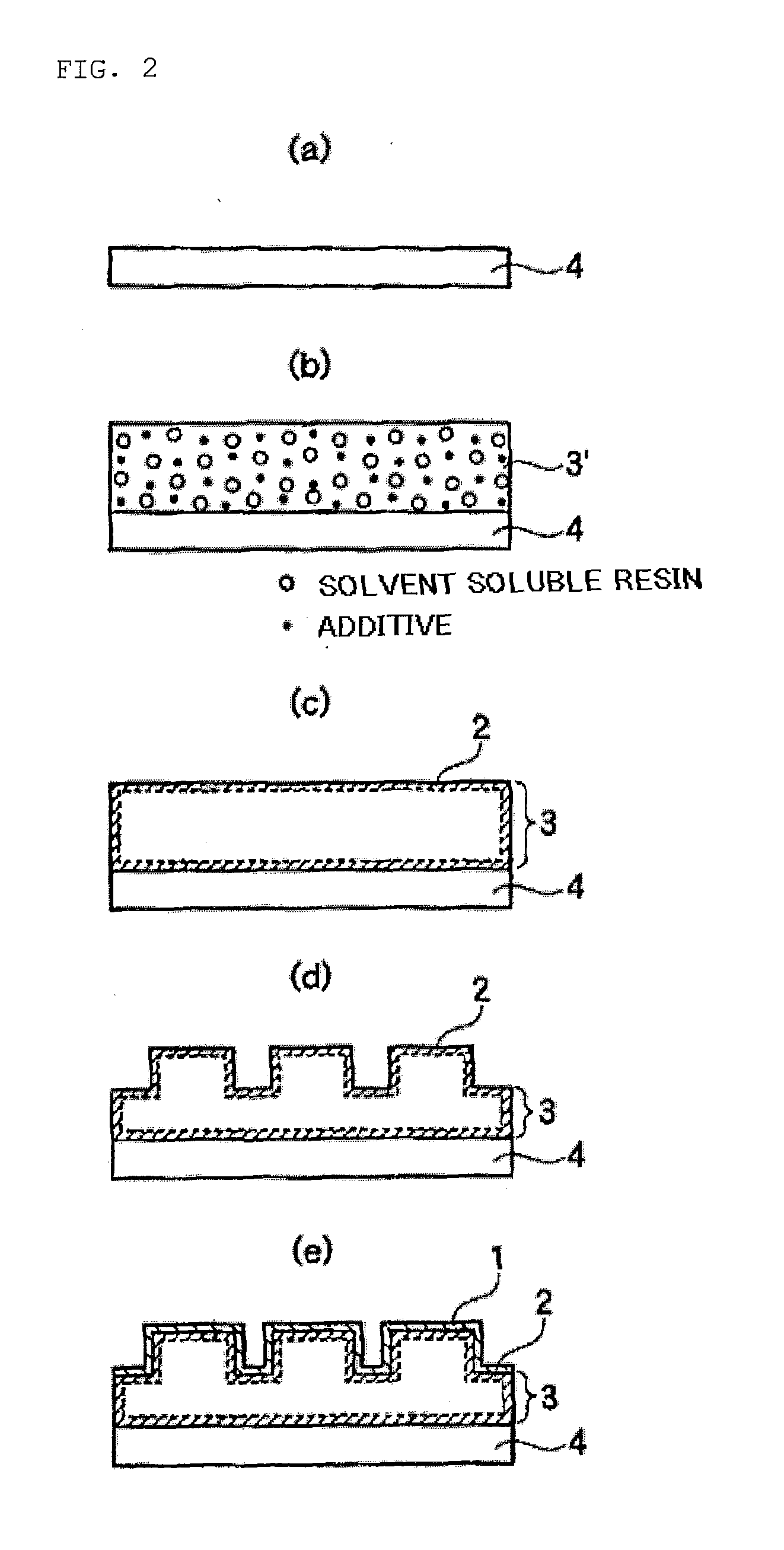Resin Mold, Production Method Thereof, and Use Thereof
a technology of resin film and release layer, applied in the field of resin film, can solve the problems of poor adhesion of oxide film to resin film, release layer shed, etc., and achieve the effect of inexpensive mass production and excellent releasability
- Summary
- Abstract
- Description
- Claims
- Application Information
AI Technical Summary
Benefits of technology
Problems solved by technology
Method used
Image
Examples
example 1
(i) Preparation of Resin (PMMA Type) for the Resin Mold
[0144]95 parts by weight of methyl methacrylate (product name=LIGHT ESTER M, manufactured by Kyoeisha Chemical Co., Ltd.), 5 parts by weight of glycidyl methacrylate (product name=LIGHT ESTER G, manufactured by Kyoeisha Chemical Co., Ltd.), and 100 parts by weight of toluene were added to a flask equipped with a stirrer device, nitrogen gas feed tube, thermometer, and tubular refluxing condenser. Thereafter, while nitrogen gas was fed into the flask, the contents of the flask were heated to 80° C., 0.5 parts by weight of dimethyl 2,2′-azobis(2-methylpropionate) (product name=V-601, manufactured by Wako Pure Chemical Industries, Ltd.) as the initiator was added, and temperature was maintained at 80° C. for 8 hours. Thereafter, the flow of nitrogen gas was stopped, 100 parts by weight of toluene was added, and the reaction was stopped by lowering temperature to obtain the resin for the resin mold. Molecular weight of the obtained ...
example 2
[0153]Except for setting the added amount of 3-glycidoxypropyltrimethoxysilane in step (ii-a) of Example 1 to 10 parts by weight, a resin mold was produced in the same manner as Example 1. The obtained resin mold was used to perform photo-nanoimprinting in the same manner as that of Example 1.
[0154]Nanoimprinting results and the obtained resin mold for nanoimprinting are indicated in Table 1.
example 3
[0155]Except for setting the added amount of 3-glycidoxypropyltrimethoxysilane in step (ii-a) of Example 1 to 1 part by weight, a resin mold was produced in the same manner as Example 1. The obtained resin mold was used to perform photo-nanoimprinting in the same manner as that of Example 1.
[0156]Nanoimprinting results and the obtained resin mold for nanoimprinting are indicated in Table 1.
PUM
| Property | Measurement | Unit |
|---|---|---|
| sizes | aaaaa | aaaaa |
| thickness | aaaaa | aaaaa |
| compatibility | aaaaa | aaaaa |
Abstract
Description
Claims
Application Information
 Login to View More
Login to View More - R&D
- Intellectual Property
- Life Sciences
- Materials
- Tech Scout
- Unparalleled Data Quality
- Higher Quality Content
- 60% Fewer Hallucinations
Browse by: Latest US Patents, China's latest patents, Technical Efficacy Thesaurus, Application Domain, Technology Topic, Popular Technical Reports.
© 2025 PatSnap. All rights reserved.Legal|Privacy policy|Modern Slavery Act Transparency Statement|Sitemap|About US| Contact US: help@patsnap.com



